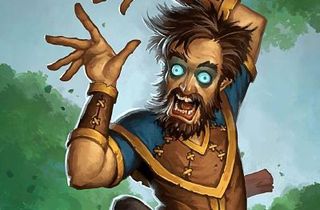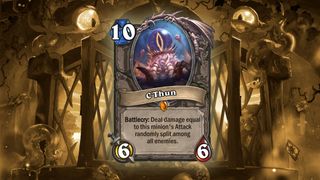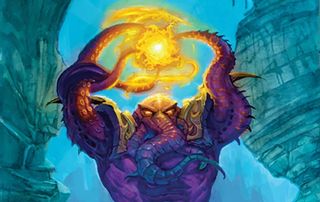How to build your deck to beat Hearthstone’s Old Gods metagame
Concentrate on curve, avoid too much tech, and more advice from our ladder expert.


Will is a professional Hearthstone player who is currently a free agent, having until recently played for ManaLight. His best tournament result was at Dreamhack Cluj-Napoca, where he finished 3rd/4th. He loves to write about the game, having contributed several articles to Team Archon’s site. You can find him on Twitch here and on Twitter here.
Whispers of the Old Gods, Hearthstone’s new eyeball-heavy expansion, arrived on April 26th and brought with it the new ‘Standard’ format for competitive play. In Standard, the oldest sets rotate out of the playable pool, which along with some judicious nerfs to some of the Classic cards, opens up design space for new and interesting mechanics and synergies that might have led to obnoxious strategies if all of the old cards were still around.
A week into Standard, it feels like we’re in a golden period in which new decks are springing up constantly, and creativity is rewarded more than ever. I personally can attest to this, having just finished top 50 legend with a version of Zoo Warlock I helped develop. Brewing a new deck doesn’t need to be a painful process, and in this article I’d like to share a few pointers that could help you rank up fast with your new creations.

Know your win condition
Thinking critically about your own decisions is the most important skill in Hearthstone, and deckbuilding is no exception to this. When you’re coming up with the idea for a new deck, you must always first ask the question: “How am I going to win games?” If the question seems obvious, that’s because it is. But it will also lead you to other similar questions, like “Does this card help me work towards my win condition?” and “Shouldn’t my deck have already won or lost by the point in the game at which this card is useful?”.
Once you start thinking along these lines, that C’thun Aggro Shaman begins to look a lot less appealing. Similarly, even though Selfless Hero is a very good one-mana minion with a Deathrattle effect, it hasn’t found a home in the slow, grindy control deck that is N’zoth paladin. Decks with a unified purpose are inherently more efficient, so it’s vital that as the deckbuilder you identify your win condition early and select cards with that aim in mind.

Build your deck with the curve in mind
When people talk about the ‘curve’ in Hearthstone, they are referring to a player or deck’s ability to efficiently utilise mana. As this video demonstrates nicely, the ‘perfect curve’ is when a player uses all of his or her available mana on every turn. Since cards are balanced with their mana in mind, the best play is generally the one that ensures optimal mana usage over the course of the next few turns.
You can build decks towards this goal by ensuring you have a good balance of mana costs distributed through the deck. A deck with five ten-cost cards is always going to be suspect, no matter how good it is at surviving until the late-game, simply because the scenario in which you have time to play however many of these you draw on average is going to be rare. On the other end of the spectrum, a deck consisting of too many one-cost cards is likely going to run into problems with running out of cards in the mid-game (although this can be compensated with a powerful card-draw mechanic like Divine Favor in Aggro Paladin or Life Tap in Zoo).
Different decks have different curve requirements depending on how long their average game will last. Having a curve that fits the likely length it will take to accomplish your deck’s game plan is an important ingredient for success. One handy tip when creating a new deck, is to look at a similar archetype and see how many cards it runs at each cost. That will give you a sense of what your intended curve should likely look like.
PC Gamer Newsletter
Sign up to get the best content of the week, and great gaming deals, as picked by the editors.
Respond to broad trends rather than individual losses
It’s incredibly tempting to change your deck immediately after a loss, and a lot of the time it feels like the correct thing to do. Struggled in the early game? Add more cheap cards. Found yourself with an empty hand late on? Surely more card draw is the answer.
Try to play at least twenty games with a build before making drastic changes
While it’s important to always examining your games critically and seek to change the deck in response to results, there’s also a lot to be said for showing restraint and waiting for more data before making alterations. No deck draws well all the time, no matter how well optimised your list is. You will always lose games. Take the longview when analysing results. Try to play at least twenty games with a build before making drastic changes, and never rule out the possibility that you’ve just been unlucky in the short term. Look for situations that recur a number of times, and are likely to come up again in the future, rather than responding directly to spectacular wins or losses.
It’s also a good idea to use tools such as the TempoStorm Meta Snapshot, which will be updated for the new set in the near future, to get a handle on what you’re likely to be up against on ladder. This will allow you to get a better sense for the metagame at large, rather than relying on your own limited data, which will always be more subject to variance.
Think about the average outcome: use tech cards wisely
A very common mistake that even seasoned deckbuilders make is trying to beat everything with the gratuitous use of ‘tech’ cards. These are cards that are designed with the intention of countering one, very specific strategy, but drop in value from below-average to downright useless when that single situation doesn’t crop up. The recently nerfed Big Game Hunter is the perfect example of this. If your opponent plays a minion with seven or more attack, playing this card works out very favourably for you—but if they don’t, then you’re left with a clunky hand and a creeping sense of regret.

To avoid this problem, evaluate the cards in your deck by thinking about what they do on average. Consider how often the tech card’s effect will be activated, and how valuable this will be to you when it happens. For Big Game Hunter, this is actually quite simple. Ask yourself how many decks are likely to play good targets for the card, and try to figure out what proportion of the time you draw Big Game Hunter it finds a target. Think also about the worst case scenario, of having to play Big Game Hunter for 5 mana without a target. How dreadful is the downside relative to the huge benefits you reap when it does find a target?
While Big Game Hunter has largely fallen out of favor in the current meta, you might well react to to the glut of Shamans, Rogues, Warriors and Paladins swarming the ladder by teching in the weapon-hating Harrison Jones. But if you find yourself seeing more Priest and Warlock, perhaps not. As compared to BGH, Harrison’s statline is considerably less harsh on the player when you are unable to activate his situational effect, so you don’t have to be quite so anxious about adding him to your deck.
Tech cards are commonly overrated by the Hearthstone community, because people have a hard time accurately evaluating their downsides, compounded by the fact human nature means you’re more likely to remember amazing moments when a card got you crazy value. Which of course isn’t to say you should never include any tech cards, but remember to think about the potential negatives as well as the upside.

You don’t need to be entirely original
As hard as people still try, claiming full credit for the creation of a deck is usually incorrect. Deckbuilding in Hearthstone is an evolutionary process: an early innovator lays out the initial blueprint for a deck, then numerous others add their own tweaks until we arrive at a final, perfectly-refined build. This is especially true of more complicated decks: Grim Patron Warrior famously underwent countless refinements over the course of many months, with the final builds looking drastically different from the early ones.
A good deckbuilder has the humility to recognise the ways in which someone else’s version might be better than their own, and is willing to try out the ideas of others rather than dismissing them without thought. So don’t be an arrogant Andrey, and don’t let your desire for acclaim get in the way of making improvements to an already strong archetype. Often small changes can lead to big results.
Most Popular



